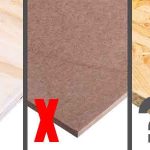The DIY Fix is reader supported. When you buy after clicking a link on our site, we may earn an affiliate commission.
Just like many other insects, it’s natural to assume that woodworm is active all year round. After all, they can cause a significant amount of damage. To achieve that, you’d expect them to be active across all seasons. But is that the case?
Most people would consider active woodworms as those seen exiting timber. This occurs during Woodworm season which begins in April.

During the colder month’s woodworm larvae will remain inside your timbers. It is at this point that they feed, but they will not exit the timber. So, it can be hard to determine if a woodworm infestation is active or not. This means that woodworm is active in some form during winter.
How does cold affect woodworm?
A woodworm infestation can cause considerable damage. As mentioned above, woodworm season begins around April time, as they start to emerge from the timber. But this doesn’t mean that they are inactive below the surface.
During the winter, it’s highly uncommon to see woodworm. This is because they will bury themselves within the timber. But, even though they are barely seen, they are still eating away at the wood and causing further damage.
However, it is also during winter when their survival can become challenging. It is known that they can survive moderatly cold temperatures, but once temperatures drop even further, they do become less resistant to cold.
Larvae are the least resistant and lower temperatures can affect them much faster. In contrast, adults can go dormant, which is the state they will remain in until the temperatures increase.
So, woodworm is affected by colder temperatures, although those temperatures can differ depending on whether they are larvae or adults.
How active is woodworms in warmer months?
Woodworm is much more active during the warmer months. Generally, they’ll begin to emerge from the timber during April. However, this does depend on the temperature, so it can be slightly earlier or later.
Once they become more active and begin leaving the timber, they will leave small holes and deposits of wood dust known as frass. At the start of the season, the woodworm will begin working away at the final layer of timber. Once it emerges, it emerges as a beetle, which might surprise many given the name.
As the temperatures rise, the woodworm emerges to begin mating and laying eggs. It is during this point that they can spread to other items within your home. They will then lay their eggs in the timber. Once the eggs hatch, the larva will work its way through your wood for as long as five years.
The Stages of Development
- Once the female emerges, she will find a mate and then lay her eggs in the timber.
- The larvae then hatch from the eggs and begin to burrow deeper. Here they will remain hidden, especially during the colder months where they are less active. This stage can remain in place for several years, as they continue to tunnel through the timber and feed off it.
- At this stage, the larvae are feeding and growing. Once they do increase in size, they change into a pupa or chrysalis. This entire process from larvae to pupa can take between 2 and 5 years depending on the species.
- After all this time, they finally become an adult beetle. This is when they eat their way out of the timber, only to start this process all over again.
The Challenge of Woodworm in Winter
We have already touched on the fact that woodworms are still active during the winter months. However, their behaviours are different when compared with warmer months. This means that they can cause significant damage without you realising.
The damage they cause is done within the timber. The larvae work their way deep into the wood, where they will remain for several years. This is where the problems arise, because you cannot see the damage and might not even know you have woodworm. There are tell-tale signs that you can spot, but these might not become apparent until the temperatures warm up.
You should look for burrow holes and tunnels in the surface of the timber. This will give you an indication that they have emerged to lay their eggs. Once the weather becomes warmer, you will be able to look for frass or powdery dust near exit holes, as well as dead or live woodworm.
Conclusion
So, while woodworms might not appear active during the winter months, they could be causing significant damage within the timber without you realising. Unless you look for clear signs, such as holes and tunnels, there is no way of knowing whether you have an infestation or not.
Winter can pose a significant challenge when it comes to identifying woodworm. Therefore, the warmer seasons are the best time to look for the tell-tale signs of woodworm.




